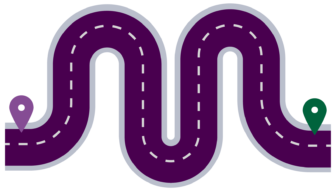There are three key questions to ask when developing a Knowledge Management (KM) strategy: where are you, where do you want to be, and how do you ensure you get there successfully? These are the three pillars crucial for the development of a sound KM strategy. At Enterprise Knowledge (EK), we define these as the Current State, Target State, and Roadmap. As simple as these terms may sound, developing a complete understanding of each is no small challenge. In this final article of a white paper series, one of EK’s KM strategy experts, Guillermo Galdamez, addresses the third, and final step: plotting a realistic KM roadmap.
Introduction
 The previous two steps provide an important foundation for the KM Roadmap. In step one, we gain a clear understanding of our starting point (the Current State). In step two, we achieve consensus on a vision for where you want your organization to be (the Target State). In step three, we now bridge the gap between them, and it is time to pull out our KM toolbox and begin to put together the initiatives, activities, and pilot projects that will not only help us realize our vision, but also garner the support from key stakeholders and remove roadblocks.
The previous two steps provide an important foundation for the KM Roadmap. In step one, we gain a clear understanding of our starting point (the Current State). In step two, we achieve consensus on a vision for where you want your organization to be (the Target State). In step three, we now bridge the gap between them, and it is time to pull out our KM toolbox and begin to put together the initiatives, activities, and pilot projects that will not only help us realize our vision, but also garner the support from key stakeholders and remove roadblocks.
A Roadmap’s Expected Outcomes
It is useful to think about what we need our roadmap to do. In summary, there are five major jobs that the roadmap needs to accomplish:
- Provide a clear path forward. The roadmap needs to be able to coherently communicate how its activities will help the organization achieve its target state.
- Align with organizational priorities. KM is more readily embraced when the organization understands how KM helps advance the organization’s goals, mission, and strategic initiatives.
- Evaluate progress. The roadmap identifies milestones for the organization to meet in the pursuit of its objectives. Thus, as the roadmap progresses, an organization can use these milestones to measure its efficacy and determine whether it is closer to achieving its intended outcomes.
- Communicate progress. A roadmap is a useful communication tool and will serve as a way to align stakeholders’ understanding of the benefits the roadmap is providing to the organization, and also the resources necessary to advance the KM roadmap.
- Provide flexibility to adapt to changes. The organization will encounter new challenges and opportunities arising from both internal and external sources. The roadmap must, therefore, provide the mechanisms to adapt so that it can achieve its intended outcomes.
A Pilot-Based Approach
One of the best ways to ensure your organization’s KM roadmap achieves these five main goals is to take a pilot-based approach. A pilot-based approach is based on agile principles and has served us successfully throughout the years, through KM initiative implementations across industries and in organizations of differing sizes. It consists of breaking down recommendations into repeatable, reproducible pilots. So, for example, instead of starting a monolithic revamp of a Communities of Practice (CoP) initiative, it can be broken down into pilots for (i) leadership and governance, (ii) success indicators and evaluation metrics, (iii) participation incentives, and (iv) CoP knowledge dissemination and institutionalization.
There are several benefits of a pilot-based approach that help cement KM within an organization:
- Speed in delivery. Because pilots are relatively short, the organization can observe tangible progress and receive benefits within weeks or a few months.
- Communicating the “What’s In It For Me.” Pilots have a very narrow scope, targeting a particular challenge for a small group within the organization. Beneficiaries know exactly what they should expect, and it is relatively straightforward to determine whether the pilot achieved its objectives. Collecting individual success stories and sharing them with the rest of the organization helps induce demand for KM and foster goodwill, ultimately increasing adoption and helping stakeholders see the direct value and benefit of KM.
- Managing complexity. Organizations often need to introduce complex practices and technologies to be able to achieve their target state, many of which they may be unfamiliar with, such as content deconstruction, semantic search, and AI. Pilots help communicate their value by breaking down these initiatives into simpler, more manageable activities.
- Reduced risk. Given their narrow scope, pilots require fewer resources than traditional enterprise-level initiatives, making them less costly and minimizing the organization’s exposure to risk if the pilots don’t meet expectations or if things change unexpectedly.
- Easier contextualization. Although there are well-established KM practices such as communities of practice, taxonomies, and lessons learned, it is still necessary to translate them and contextualize them to the operational realities of the organization. Pilots do this by implementing a KM practice to a specific business need for a defined organizational group, taking into consideration their organizational constraints, priorities and operational realities.
- Creation of learning opportunities. The execution of each pilot represents an opportunity to reflect on what went well, what didn’t go as expected, and what changes the team needs to consider prior to the next iteration of the pilot.
Where to Start?
The list of pilots to complete the roadmap can be extensive, and it is not feasible for the organization to do them all at once. Again, taking a page out of agile, we prioritize the pilots and place them in a backlog of activities. Although there are several ways in which activities can be prioritized, a common way is to consider their business value, foundational value, and their technical complexity:
Integrating Change Management, Governance, and Metrics
It is important to maintain strong governance over the roadmap to ensure that KM delivers its expected benefits to the organization, and that the initiative can be sustained through time as the organizational environment changes. For this reason, it is useful to organize and classify related pilots under different workstreams. Workstreams can be assigned to individuals and teams who are most aligned with its activities, or who are most likely to benefit from them. This provides clear lines of responsibilities and accountabilities for the delivery of the roadmap.
In order to be able to demonstrate progression in KM maturity and the achievement of the target state, the roadmap must define success indicators and milestones. It is necessary to call these out explicitly to be able to track the success of the KM roadmap and, in addition, define metrics that will track the changes in staff’s behaviors as they support the outcomes expected from the newly-introduced KM practices and tools.
The roadmap can only succeed if the new practices and new tools it introduces are adopted and implemented by an organization’s staff. Practicing and embedding KM in the organization will undoubtedly necessitate changes to how people work, and it will require an integrated change plan. It is only natural that some may be passively or actively resistant, so it will be important as part of the KM roadmap to anticipate people’s fears and misgivings about the proposed changes. However, we don’t need to be afraid of resistance – it represents an opportunity to develop better solutions that will work for the organization and its people. Communication is key. The KM project team, needs to help their peers and colleagues by clearly outlining:
- New behaviors that will be expected of them;
- How the organization will support them in learning new ways of working or becoming familiar with new concepts;
- Benefits they will receive from KM, as both individuals and teams; and
- Mechanisms to provide feedback on the pilots.
Concluding Remarks
A practical KM roadmap creates opportunities for KM to achieve its target state by delivering tangible value early on and by winning over advocates. Efforts are sustained through an integrated change plan. However, it is not enough to do KM for its own sake, and to check off activities – the KM strategy must focus on outcomes that support an organization’s wider strategic objectives, and brings benefits to its staff.
Looking for assistance in defining and implementing a KM roadmap? Contact us for help developing a KM strategy tailored to your organization, your vision and your priorities.





